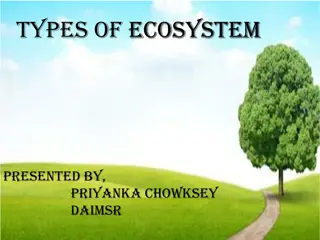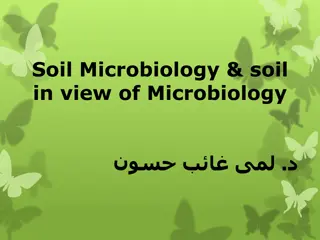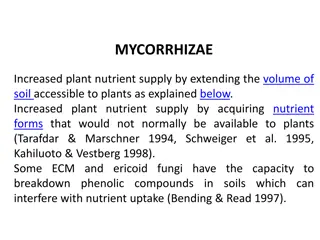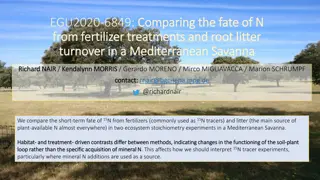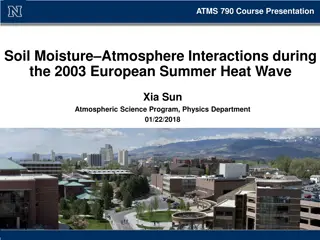Understanding Soil Characteristics and Ecosystem Interactions
This content explores various aspects of soil characteristics, including factors influencing soil thickness, the role of bedrock in soil quality, optimal soil mixtures for plant growth, the impact of living organisms on weathering, and the formation of soil. It also discusses how animals can help soil retain water and identifies the richest components in fine-grained soils.
Uploaded on Sep 21, 2024 | 0 Views
Download Presentation

Please find below an Image/Link to download the presentation.
The content on the website is provided AS IS for your information and personal use only. It may not be sold, licensed, or shared on other websites without obtaining consent from the author. Download presentation by click this link. If you encounter any issues during the download, it is possible that the publisher has removed the file from their server.
E N D
Presentation Transcript
Soil in Anchorage, Alaska, is very shallow. Which is a biotic factor that plays the largest role in limiting the soil thickness in Anchorage? A. Precipitation falls mainly as snow or frozen rain. B. Cold temperatures keep the soil frozen for many months of the year. C. Decayed plant material is limited due to short growing seasons. D. Shade from the mountains blocks sunlight from reaching the soil.
This diagram shows a layer of bedrock under topsoil. How can the type of bedrock under soil affect the characteristics of the soil? A. by preventing soil erosion B. by providing surface area for nutrient accumulation C. by contributing small rock particles to the soil D. by absorbing excessive rainwater
The BEST soil mixture for plant growth and drainage is A. silt, pebbles, and clay. B. humus, clay, and sand. C. sand, rocks, and clay. D. clay, silt, and rocks.
Living organisms have a role in weathering and erosion in the ecosystem. Which statement describes the role of bacteria and fungi? A. They increase water access and flow and help aerate the soil. B. They hold soil in place during high winds. C. They grow within cracks of rocks, breaking the rock into small pieces. D. They decompose organic matter in the soil.
The table shows some of the characteristics of the soil in an area of land. Which characteristic of this area indicates that the soil was formed as a result of the interaction between organisms and their environment? Characteristics Surface Area Soil Color Soil Content Flat Dark brown Humus, sand, and clay Gritty Texture A. The soil color is dark brown. B. The soil feels gritty. C. The area is flat. D. The soil contains humus.
Soil will pack down over time which decreases the ability of the soil to hold water. Which animals would BEST help the soil hold water? A. cattle making depressions with their hooves B. horses making trenches when they gallop C. sheep pulling up plants by their roots D. earthworms making tunnels under the surface
The finest-grained soils are richest in A. sand. B. clay. C. iron. D. humus.
Topsoil is considered to be MOST fertile when it has a A. low sand content. B. high parent rock material level. C. low pH level. D. high organic matter level.
Some plants need to be in an environment where water drains easily. Which type of soil content will BEST benefit these plants? A. clay B. shale C. sand D. silt
A large quantity of heavy rain falling in a short time period will MOST likely A. reduce the amount of nutrients in the soil. B. reduce oxygen levels in the soil. C. increase the number of minerals in the soil. D. increase the temperature of the soil.
Which BEST explains how nutrients get into soil? A. through exposure to air B. by rocks eroding C. through decaying matter D. by absorbing sunlight
List and describe the 3 main soil horizons in the soil profile.
Soil that drains slowly MOST likely has a high amount of A. clay. B. peat. C. ash. D. sand.
Before large trees could grow on Earth, what had to happen first? A. Earth s gravity accumulated to modern levels. B. Rocks were eroded to form soil. C. Molten rock warmed Earth s interior. D. Volcanoes exploded to form mountaintop lakes.
What process makes it possible for the nutrients from organic material to be added to soil? A. erosion B. succession C. decomposition D. weathering
A plant that needs well-drained soil would grow BEST in soil made mostly of A. silt. B. clay. C. sand. D. humus.
How does the presence of organic matter contribute to good soil? A. It keeps the soil cool. B. It adds nutrients to the soil. C. It destroys bacteria in the soil. D. It helps the soil to dry out.




